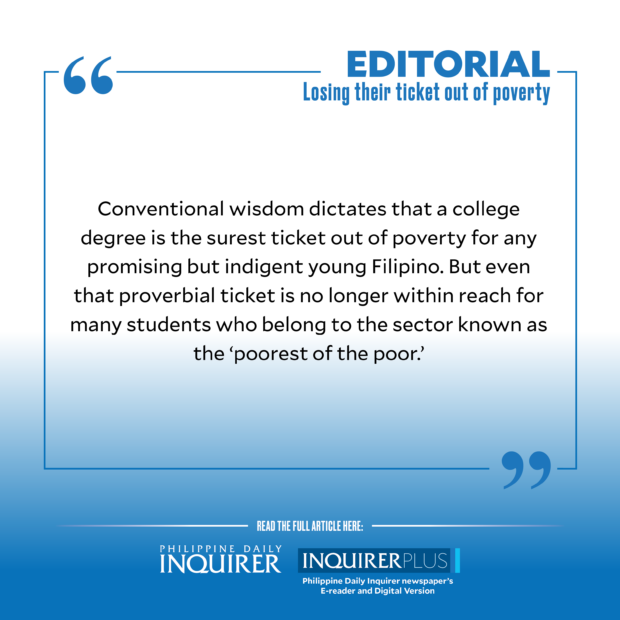
Conventional wisdom dictates that a college degree is the surest ticket out of poverty for any promising but indigent young Filipino. But even that proverbial ticket is no longer within reach for many students who belong to the sector known as the “poorest of the poor.”
According to the report of the Second Congressional Commission on Education (EdCom II), the number of students in extreme poverty who are receiving tertiary-level education assistance from the government has declined steeply, from 204,234 in 2018 to a mere 69,887 in 2022.
Notably, the proportion within the total distribution of beneficiaries in that demographic has decreased just as much, from 74.24 percent to 30.74 percent for the same period, based on the aptly titled “Miseducation: The Failed System of Philippine Education” report.
Inequitable distribution
Such “inequitable distribution and utilization” of resources has “resulted in unequal access to higher education,” observed the report submitted to Congress last week.
Under Republic Act No. 10931, or the Universal Access to Quality Tertiary Education Act, Filipinos enrolled in state- or privately-run college or technical-vocational institutions are entitled to a tertiary education subsidy (TES) administered by the Unified Student Financial Assistance System for Tertiary Education (UniFAST) board. The subsidy covers tuition and other fees, as well as expenses on books, school supplies, transportation and miscellaneous needs, of academically capable but financially disadvantaged citizens.
The law specifies that the TES grant shall be prioritized in the following order: students who are part of households included in the Listahanan 2.0, ranked according to per capita household income; and students not part of the Listahanan 2.0, ranked according to per capita household earnings based on submitted proof of income. The Listahanan is the Department of Social Welfare and Development’s official database of poor families eligible for its antipoverty programs.
Dramatic drop
There’s a caveat, however: “That such prioritization shall not apply to Filipino students in cities and municipalities with no existing SUC (state university or college) or LUC (local university or college) campus,” or those referred to as “placed with no SUC/LUC” (PNSL).
It is precisely the latter group that has apparently dislodged the poorest members from the program.
The EdCom II report noted that the dramatic drop in indigent TES beneficiaries seemed to correlate with a huge spike in PNSL grantees, whose number rose from 70,684 in 2018 to 157,484 in 2022.
“This shift is notable as students in the PNSL category may not necessarily be impoverished, contradicting the progressive goal of [RA 10931],” the report said, adding that: “The substantial rise in PNSL grantees, both in number and proportion, suggests that the TES is no longer targeted toward those who need it most.”
The commission proposed a “reevaluation” of the definition of PNSL, so that the grant of TES could “better align” with the objectives of the law and ensure equity among grantees.
Geographic disadvantage
Such recommendation is logical and sound: The absence of SUCs or LUCs in any given local government unit does not mean students there necessarily lack access to quality higher education. Moreover, their geographic disadvantage cannot be reasonably compared with the difficulties of their peers who are struggling to put food on the table.
The EdCom II report even cited the case of Koronadal City in South Cotabato which technically lacks higher education institutions (HEIs), even though there are three state university campuses in nearby towns.
“This situation underscores the need for a comprehensive review of the definition of accessibility for HEIs across different cities and municipalities, ensuring that public resources are utilized efficiently and equitably while mindful of the quality of the geographically accessible public HEIs,” the report said.
A moral repugnance
Another crucial finding in the report is that much of the budget for universal access to tertiary education has been allocated toward programs that are not targeted toward the most needy. As a result, “students from poorer households tend to have lower qualifications, lowering their chances to win their admission slots against students who are better off, further widening the household income inequalities among students found in SUCs,” the report noted.
The key takeaway here is that indigent students should not have to compete for access to educational resources with those who already have plenty. That state policy fosters such outrageous social inequity is not only a bureaucratic failing—it is a moral repugnance of the highest order.
After all, the intent of universal education is for those at the bottom of the economic ladder to get their fair chance to break the shackles of poverty. More than ever, the government must do its part to help our poorest youth achieve this increasingly unreachable dream.